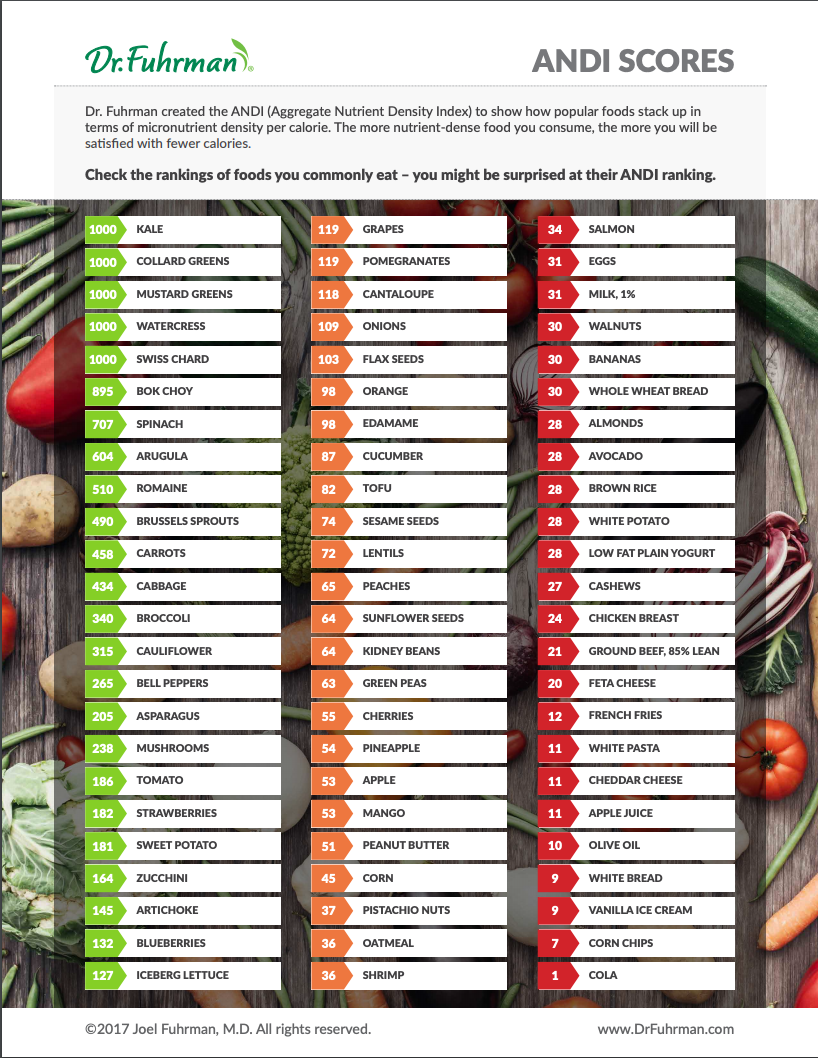If you want to build muscle or lose fat, then nutrient dense foods are the most bang for your buck.
But before we go into some of my favorite food choices, let us first understand the concept of nutrient density.
What Is Nutrient Density?
Nutrient density is the amount of nutrients that your food gives in a ratio according to the number of calories it supplies. Simply put, higher nutrient density means that it gives more nutrients than the calories it supplies. “Not all calories are the same” is based on this principle.
Always aim to get the most nutrients out of the food you consume. This will help improve your body transformation, whether your goal is fat loss or muscle gain.
How Is Nutrient Density Calculated?
Just like how there are ways to track calories for different foods, there is also a way to calculate nutrient density.
Dr Joel Fuhrman created the ANDI (Aggregate Nutrient Density Index) for this very purpose. His 1,000-point ANDI ranks foods based on their micronutrient concentration. A 1,000 score indicates a food contains the highest number of micronutrients per calorie.

Dr Furhman’s ANDI Score Chart
The Dos And Don’ts
Few of us have the ANDI scale committed to memory.
Thanks to my good dietary habits as a professional athlete, I know which type of foods to avoid.
For starters, stay away from processed foods. They lack nutritional content and instead contain artificial flavors and preservatives.
Instead, opt for whole foods as much as possible in your diet. This includes fresh foods like vegetables, fish and proteins like red meat which are nutrient dense foods. These items can be easily found at your farmers market.
Forget about exotic foods and focus on locally sourced produce like fruits which are in season. This not only gives you more variety in your meals, it also helps to support your local farmers.
Below are four of my favorite nutrient dense foods. I also share some quick and easy ways I prepare meals using them.
Kale
Kale is among the most nutrient dense foods on the planet and is ranked number one on the ANDI.
It is a leafy green belonging to the cruciferous vegetable family which includes brussels sprouts, broccoli and collard greens.
According to the US Department of Agriculture (USDA), kale is a rich source of vitamins A, K, B6 and C while also providing potassium, copper and other minerals. These are essential vitamins, minerals and antioxidants that support your vision, immunity, skin, heart, bone and blood health.
With a cup of raw kale giving just a total of 33 calories, kale more than lives up to its reputation as a superfood.
You can use kale as a garnish or side. Garlic goes well with kale and I fry them over a hot skillet with some olive oil. Stir occasionally until kale is bright green and tender.
Enjoy!
Spinach
Even Popeye knows spinach is good if you want to build strong muscles. But what about its nutritional content?
Spinach is one of the best sources of potassium and magnesium. These electrolytes are necessary to maintain muscle mass and preserve bone mineral density.
One cup of raw spinach provides 181% of the daily recommended value for vitamin K and 56% of the daily value for vitamin A (beta carotenoids). It also contains vitamin B2, B6, E and C. Spinach is high in fiber, iron and antioxidants which fight oxidative stress caused by free radicals in the body.
The high nitrate and potassium content in spinach have been shown to moderate blood pressure levels and decrease the risk of heart disease.
You don’t have to be a vegetarian to enjoy spinach. It is very easy to incorporate spinach into your meals. You can use spinach in sandwiches, wraps and quiches. Spinach is also a great addition to a vegetable smoothie.
Blueberries
Whether fresh or frozen, blueberries are extremely tasty and packed full of nutrients.
Just one cup of blueberries provides 24% of a person’s recommended daily allowance of vitamin C.
On top of its delicious taste, blueberries contain plenty of flavonoids which are powerful antioxidants.
Blueberries have strong amounts of iron, phosphorous, calcium, magnesium, zinc and vitamin K. All of these help to build and maintain bone structure and strength.
Furthermore, blueberries are low in calories and useful in fat loss diets. They also make for a great topping on morning cereal, or for a quick blended smoothie with milk and yoghurt.
Grass-fed Beef
Grass-fed beef contains less fat than grain-fed beef.
Although it does not rank comparatively with the likes of kale or spinach on the ANDI, grass-fed beef provides more protein per pound than both.
You need to consume between roughly a gram or a gram and a half of protein per lb of your bodyweight to build muscle. So, unless you are willing to eat a ridiculous amount of kale and spinach, then grass-fed beef is your next best choice outside of chicken breast.
Grass-fed beef is a source of Omega-6 polyunsaturated fats and Omega-3s. These fatty acids help prevent inflammation, contribute to brain development, and regulate the heart, immune and nervous system.
After reading this, treat yourself to a nice juicy steak with salt and pepper.
